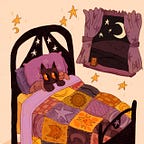This Part of Feminism is Problematic. Here’s Why We Still Need It.
Our criticisms can blind us to reality.
Feminism is why so many muscular women are on our television screens, in our books, on our posters. It’s why sassy women are in our Netflix shows, full of hair flips and bright lipstick. There’s a sort of shining savagery in characters like this.
It’s a problem.
For a long time, depictions of characters like this have been causing serious issues for women. Because they provide such a narrow alternative depiction of what a woman can be, they’ve been wrapping women in yet another set of unrealistic societal expectations.
I’ve scoffed with my friends at characters like this, especially since depictions of them often go very wrong: an axe-throwing supernova of a teenage girl whose role ultimately begins to revolve around her male love interest, or a woman who doesn’t like wearing lipstick who’s portrayed by an actress wearing heavy makeup for the screen.
It’s easy to forget that characters like this are still important. The muscular women, the sassy women, the women who don’t like lipstick — for many, they represent the autonomy which women have been deprived of for so, so long.
In 2013, Lorde released “Team” as part of her debut album, Pure Heroine. It was a big hit, played and replayed on radio stations so many times that I gained an ability to recognize it almost subconsciously. But it took me some time to recognize that this song also confronts gender roles in our society.
Call all the ladies out
They’re in their finery
A hundred jewels on throats
A hundred jewels between teeth
Although this isn’t a caricature depiction of defiance of gender roles, it has a similar effect. With their hundred jewels, women are depicted as powerful within society, which speaks to a carnal desire among women for autonomy.
That desire is expressed nearly everywhere — on radio stations, in paintings and on screens. Since before World War II, depictions of muscular women and sassy women and women who don’t like lipstick have personified power. That is what they mean to so many women.
It’s impossible to deny that depicting only characters like this as examples of female autonomy is inherently problematic. Thankfully, we’ve been moving away from that.
The Barbie movie, which came out not too long ago, strives to depict a wide range of women as powerful. Blonde women who wear pink, poofy dresses. Women of different ethnicities. Women with different body types. It’s amazing. It’s exciting. It’s incredible.
Amidst all this change, it’s easy to get carried away — to shun depictions of muscular women with scathing words as we run towards a new light. But by doing that, we’re ultimately imposing new limits on women, again restricting them from full autonomy.
As YouTuber schnee points out, depicting women in a wide range of different roles is a better way to represent women. He points out that Emmy award-winning television show Arcane is an amazing example of this.
Arcane depicts women in white dresses, women who tower in height, women whose eyes soften at their lovers — all of whom have agency within Arcane’s story.
This is what women want: to receive assurance that they’ll have autonomy whether they’re small or tall, whether they like to dress in shorts or sweatpants, whether they speak loudly or not.
We still need powerful, muscular women in our movies and books. We just also need powerful women who aren’t muscular, who aren’t loud. Most of all, we need women who have autonomy despite not desperately clinging to it with every breath they take.
Women need to know that autonomy should not be granted conditionally. That begins with acceptance. Not rejection.
As Barbie would say, you can be anything.
For more from me on books, friend or follow me on Goodreads!
